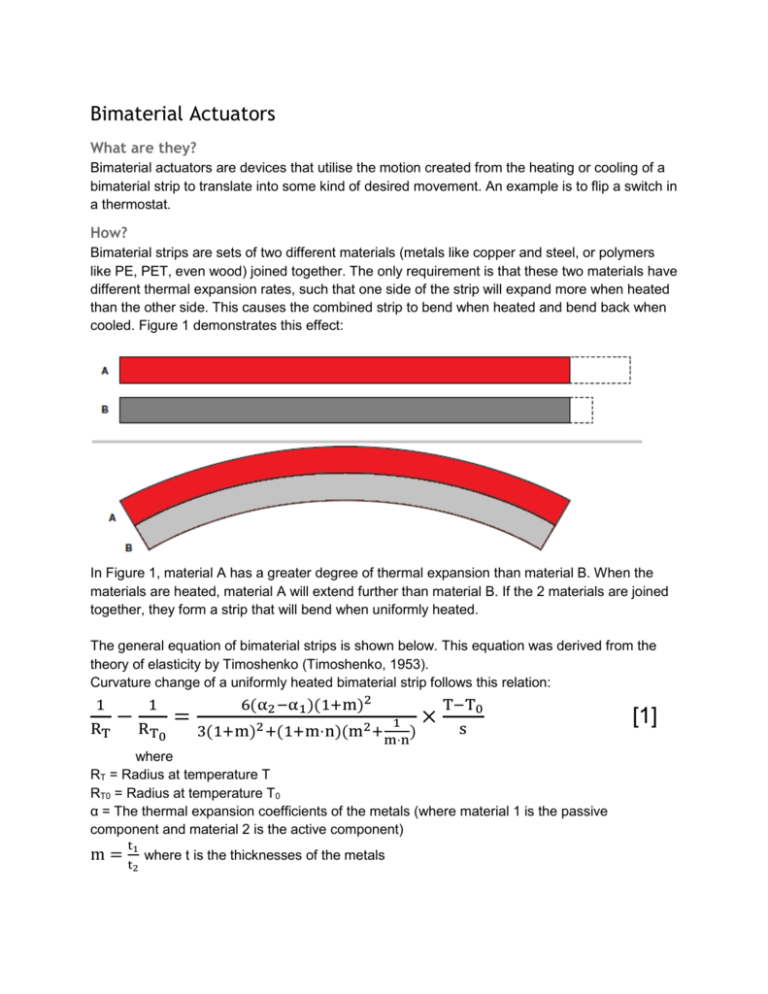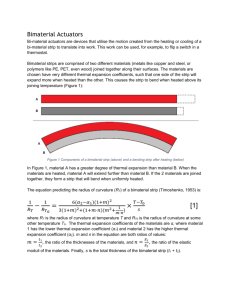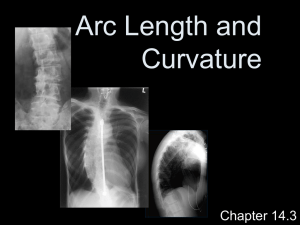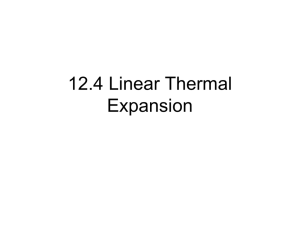Bimaterial Actuators: Design, Equations, and Applications
advertisement

Bimaterial Actuators What are they? Bimaterial actuators are devices that utilise the motion created from the heating or cooling of a bimaterial strip to translate into some kind of desired movement. An example is to flip a switch in a thermostat. How? Bimaterial strips are sets of two different materials (metals like copper and steel, or polymers like PE, PET, even wood) joined together. The only requirement is that these two materials have different thermal expansion rates, such that one side of the strip will expand more when heated than the other side. This causes the combined strip to bend when heated and bend back when cooled. Figure 1 demonstrates this effect: In Figure 1, material A has a greater degree of thermal expansion than material B. When the materials are heated, material A will extend further than material B. If the 2 materials are joined together, they form a strip that will bend when uniformly heated. The general equation of bimaterial strips is shown below. This equation was derived from the theory of elasticity by Timoshenko (Timoshenko, 1953). Curvature change of a uniformly heated bimaterial strip follows this relation: 1 1 6(α2 −α1 )(1+m)2 T−T0 1 RT R T0 s 3(1+m)2 +(1+m⋅n)(m2 + ) m⋅n where RT = Radius at temperature T RT0 = Radius at temperature T0 α = The thermal expansion coefficients of the metals (where material 1 is the passive component and material 2 is the active component) − m= t1 t2 = where t is the thicknesses of the metals × [1] n= E1 E2 where E are the elastic moduli of the metals and s = the total thickness of the strip (t1 + t2) The parameters with the clearest effect on the degree of bending are the thermal expansion coefficients. A larger difference in the thermal expansion coefficients creates a larger bending effect. Additionally, a greater ΔT and smaller thickness also increases the bending of the bimaterial. There is no clear relationship between the two ratios and the degree of bending. The degree of bending is maximised when the ratios follow a certain relation. Through optimization, the ideal relationship between the two ratios is found to be: m= √n n This relation matches with the relationship between cross-section, modulus of elasticity, and stiffness. This tells us that the stiffnesses of the materials should be matched (as close as possible) to maximize bending. Typically, the first term in the equation can be calculated for a bi-material with known thickness and modulus ratios into a material constant known as specific curvature or flexivity. Specific curvature is the figure of merit for the bendability of bi-materials. Additionally, if the material is initially flat then RT0 is ∞. The equation then simplifies to: 1 RT =k T−T0 s [2] Requirements The material with the higher thermal expansion coefficient is often called the active component, while the material with the lower thermal expansion coefficient is the passive component. In addition to having different thermal expansion rates, the two components must also have similar stiffness (as shown in the equation above). The stiffness similarity is important to ensure the components are able to act on one another during heating and cooling. If one material is significantly stiffer than another, the softer material will not have a noticeable effect on the stiffer one. For the material to bend significantly it should not be too brittle. Finally, for a bi-material to bend significantly it must be very thin, so the material should also be formable to thicknesses of 10100 μm. Materials Common bimaterial strips are usually made from steel and copper or steel and brass. These strips are found often in thermometers or switches (Betts, 2006). Less common polymer bimaterial strips use different thicknesses of PET and PE (Blonder, 2013). Higher-end bimaterial strips use alloys of iron, nickel, manganese and/or chrome of varying compositions as the active component with Invar (or a similar alloy) usually serving as the passive component (Webster, 1999). These higher-end strips use materials with a greater Δα and more similar moduli to improve performance. The two components may be joined in any way that holds the materials together along their length. This includes rivets, welding (Capgo Pty Ltd., 2010), roll-joining (cold bonding) (Kanthal AB, 2008), or adhesives (Blonder, 2013). Equations These equations are all derived from [1] using simple principals of trigonometry. For the following set-up: Deflection (unhindered) of a uniformly heated bimaterial strip follows this equation: 𝐀= 𝐚𝐋𝟐 𝟒𝐬 ⋅ 𝚫𝐓 [3] where A = Deflection in mm a = Specific deflection (in K-1) Specific deflection is a term that measures a material’s change in longitudinal curvature per unit temperature change. The term is a variation of flexivity, where flexivity is twice the value of the specific deflection. L = Length of strip in mm s = the total thickness of the strip in mm ΔT = Change in temperature (K) To calculate the force exerted by a deflecting bimaterial the average Young’s modulus is used. Force of a suppressed deflecting heated bimaterial strip thus follows this equation: P= aEBs2 L ⋅ Δ𝐓 where P = Force in N E = Young’s Modulus in N/mm2 B = Width in mm a = Specific deflection (in K-1) ΔT = Change in temperature (K) [4] Our Application We require a hinge that will actuate to sides of a frame about 90°. r θ L To achieve this, the bimaterial needs to have a certain deflection, A, relative to its length. To calculate the deflection first we must calculate the required angle of curvature, θ, for our hinge to operate. As we know the length of the arc to be the length of the bimaterial strip we can calculate the chord length (straight line between the ends of the arc) with respect to the angle of curvature and radius of curvature, r : θ Chord length = r × 2sin( ) [5] 2 The radius of curvature is calculated using the arc length (bimaterial length) and the angle of curvature: Radius of curvature = r = L θ ) 360 (2×π× [6] Because the chord length must also be such that the sides of the blinds reach 90°, the chord length can also be calculated with respect to the arc length (bimaterial length) using the Pythagorean theorem: Chord length = √2 × (½ L)2 [7] When these equations are combined the arc length cancels out and we are left with the angle of curvature which is approximately 159.5°. The angle of curvature and radius of curvature can now be used to calculate the deflection following this equation: Deflection = A = r θ 2 sin 2 − r 2 tan θ 2 [8] It can be seen in equation 2 that the deflection amount increases with increasing length and decreasing thickness. The bimetals available from IMPHY have a lower thickness limit of approximately 0.08mm. Specific deflections of bimetals from the same IMPHY document ranges from 9.8x10-6/K to 20.8x10-6/K. Calculated specific deflections of other bimaterials (including bi-polymers), however, can potentially exceed 120x10-6/K. References Betts, J. (2006). John Harrison (1693–1776) and Lt. Cdr Rupert T. Gould R.N. (1890–1948). Greenwich: National Maritime Museum / Royal Observatory. Blonder, G. (2013, September 30). C)) Motion Bimorph Material. (J. Leung, Interviewer) Capgo Pty Ltd. (2010). Bimetalic strips. Retrieved from Capgo: http://www.capgo.com/Resources/Temperature/BiMet/BiMetallic.html IMPHY S.A. (n.d.). Thermostatic Bimetals. Paris. Kanthal AB. (2008). Thermostatic Bimetal Handbook. Hallstahammar: Kanlthal AB. Timoshenko, S. (1953). The Collected Papers. New York: McGraw-Hill. Webster, J. (1999). The Measurement, Instrumentation, and Sensors Handbook. Boca Raton: CRC Press LLC.






